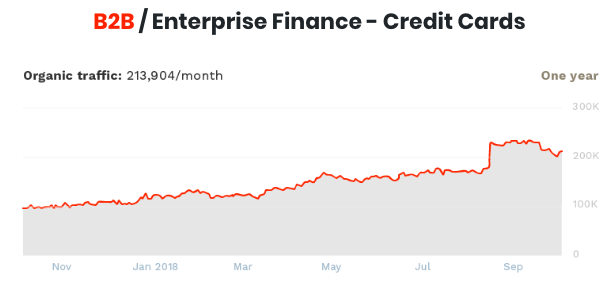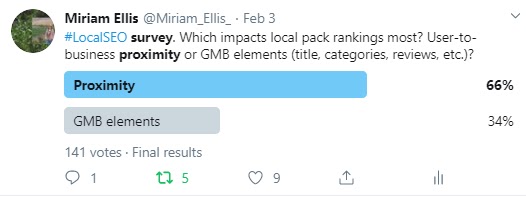Posted by amandamilligan
One of the best ways (and in my opinion, the best way) to earn top-quality links is to create your own studies, surveys, reports, etc., and pitch them to online publishers. This is what we do at Fractl, because it’s a tried-and-true way to elevate organic growth:



Over the years, we’ve received a lot of questions about what results to expect. Sure, everyone wants links now, but where does the real growth come in, and how long does it take? And in either case, people want to know what wins they can report on to their superiors, even in the short-term.
There are so many benefits to this combination of content marketing and digital PR, and I’ll walk through what you can realistically expect, and feature examples and data from our experience working with Porch.com.
Short-term benefits
It’s true that content marketing is an investment, which I’ll explain properly in the next section. But there are certainly short-term wins you can celebrate and report on, and that can have an impact on your business.
We started working with Porch.com in early 2018. We created 4-5 content projects per month for them back then, and I’m going to show you two of our early wins — a small win and a big win — so you can get a sense of what’s possible as well as what’s probable.
The small win: “Fixer Upper” by the numbers
This project was my idea, so naturally I think it deserved way more coverage. It was during the heyday of “Fixer Upper” featuring Chip and Joanna Gaines.

We secured top-tier coverage for it on Apartment Therapy, and while I would’ve liked to have seen more media coverage, there are still plenty of wins to identify here (and elements for you to keep an eye out for in your own content):
- Brand mentions: Porch is mentioned four times in the article (six if you count image credits). Every time your brand is mentioned, you’re upping your brand awareness.
- Link quality: The article linked to our project three separate times! (Bonus: More links means higher likelihood of referral traffic.) The site has a domain authority of 90, making it a very high-value earned link.
- Audience relevance: Porch is about connecting people to home renovation contractors. Their audience probably has a ton of overlap with the Apartment Therapy audience, and are presumably interested in improving the look of their homes.
- Publication readership: Then there’s the matter of the publication’s statistics, which can help you get a sense of potential reach. SimilarWeb is used by tools like Cision and Meltwater to highlight publications’ readership. In this case, Apartment Therapy is ranked #17 in the “Home Garden” category of sites, and has an estimated 9.16 million visitors per month.
So, even in one average-performing project, you can get some great links and brand exposure.
The big win: “Cooking Nightmares”
Okay, “big” win is kind of an understatement. This campaign was a huge win and remained one of our top-performing projects for Porch.

We surveyed people of all ages to determine their cooking skills and confidence, and then broke the results down by generation. People found the results fascinating, and all-in-all, the project garnered about 50 dofollow links.
In measuring this project’s success, you can look at the same qualities I mentioned for smaller wins: brand mentions, link quality, and audience relevance.
But here are some other considerations for bigger wins:
- Amount of coverage: The project went wild, earning media coverage on Washington Post, USA Today, Bustle, Thrillist, MSN, Real Simple, Southern Living, Better Homes & Gardens, and more. This coverage meant more high-quality links and significantly more brand exposure, including to a more general audience.
- Nature of brand mention: Exactly where and how is your brand mentioned? For example, in the Washington Post coverage and Thrillist coverage, they mentioned Porch.com in the second sentence. Bustle included a description of what Porch.com is: “an online resource for connecting homeowners and contractors,” which not only gets the Porch name out there, but also explains what they do.
- Writer connections: The more writers who are happy with what you’re pitching, the higher the chance they’ll open your next email. All secured media coverage is a win in this way, but it’s a significant element that’s often overlooked.
There are plenty of short-term wins to this kind of work, but odds are you’re looking for sustained growth. That’s where the long-term benefits come in.
Long-term benefits
On our site, we have a full content marketing case study that details the impact of the work we did for Porch.com in the span of a year.
That includes building links from 931 unique linking domains and adding 23,000 monthly organic visitors to the site.

This is the kind of long-term growth most people are looking for, and the key is that all of this work compounds.
Building authoritative links is critical to off-site SEO, as Google views your site as more of an authority, which subsequently means your on-site content is more likely to rank higher. And when people see your brand mentioned in the media because you’ve completed these interesting studies, they’re more likely to click on your content when they see it later because they’re familiar with you, again signaling that you have quality content.
This is our philosophy on things:

And this doesn’t even include the brand awareness aspect that I mentioned before. Which is why, to really assess the long-term impact of a content marketing and digital PR investment, you can look at the following:
- Backlink portfolio health: High-quality, relevant links will always be valued, even if they’re older. But newer links can signal to Google that you remain relevant and continue to actively provide value to audiences.
- Organic brand mentions: When your brand name is consistently in the media, it increases the chances people know who you are. Are your branded searches increasing? What are people searching for related to your brand? Are you appearing more often organically in content?
- Organic traffic: This is the primary metric many look at, because as I mentioned, earning brand coverage and links from top publishers means you’re building your authority, which improves your chances of ranking in Google and for being trusted by audiences, all of which impact your organic search numbers.
We ended up working with Porch.com for longer than a year, from about January 2018 to March 2020. In total, we earned them 1,894 dofollow links and the brand mentions and awareness that accompanied all of that media coverage.
But I want to show you what it looks like to get to this place of growth, and how it’s not by going viral on a monthly basis. It’s about sustained, ongoing work.
This is what it looked like for our work with Porch:

As you can see, we had some projects that earned a very high number of dofollow links. This often occurs when you’re producing a high volume of content over the course of many months.
However, the bulk of your content will fall in the average. Most of our work earned somewhere between 1 and 50 dofollow links, with top performers in the 50 to 100 range.
To see this spread, you have to keep doing the work. You won’t get all of those projects that earn 50-100 dofollow links right off the bat and in a row, and even if you did, while you’d get a big boost, it wouldn’t last you forever. You have to demonstrate your ongoing effort to provide value.
Conclusion
It’s true that content marketing is a long game, at least in order to see significant growth for your company. But that doesn’t mean there aren’t wins in the short-term. You can absolutely see a lift from a high-performing project and at the very least start setting up a stronger foundation for brand awareness and backlink building.
Sign up for The Moz Top 10, a semimonthly mailer updating you on the top ten hottest pieces of SEO news, tips, and rad links uncovered by the Moz team. Think of it as your exclusive digest of stuff you don't have time to hunt down but want to read!
















